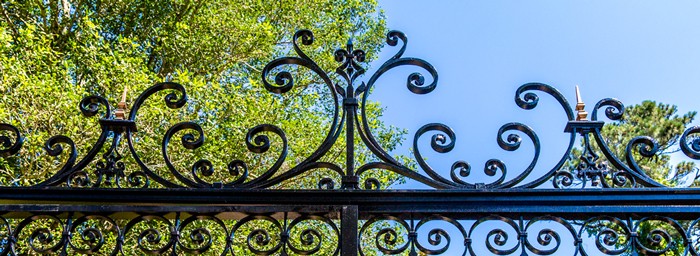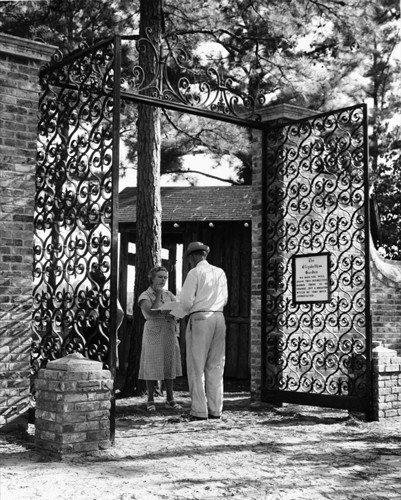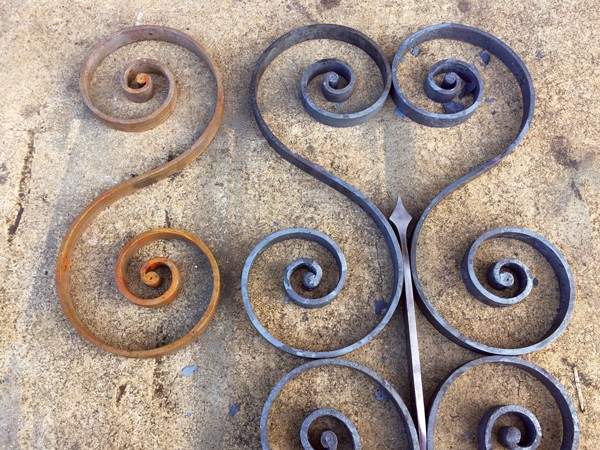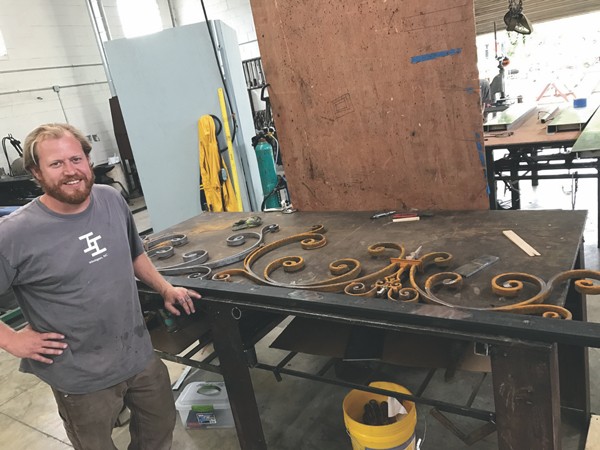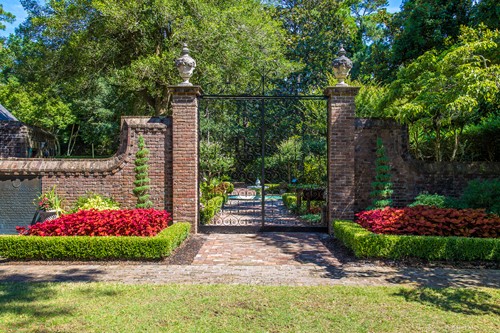Shhh…History Spoken Here
by Sandy Semans
Be very quiet and if you allow your imagination to be your guide, you can travel back almost all the way to “days of old, when knights were bold, and everyone had a chamber maid” just by walking through the Great Gates at Elizabethan Gardens.
Recently restored to their original condition and re-hung at the Gardens, the antique Great Gates have witnessed the comings and goings of the elite for more than a century – perhaps even more than two centuries!
“There’s something magical about walking through the Gates,” said Carl Curnutte, Elizabethan Gardens executive director. “You instinctively know that they are old and that they have witnessed many interesting tales over the decades – perhaps even over centuries.”
The Gates are made of wrought iron that was hand-forged by a blacksmith using an anvil to hammer each piece into the needed shape. The elaborate designs and functions of decorative wrought iron made it an item owned only by the wealthy and often was considered more art than utilitarian.
The location of where the Great Gates were first hung is still a mystery, but the detail and cost most assuredly point to a “monied past”. Perhaps their purpose was to keep riff raff out of the private estates of European nobility. Or they might have been – like now – gates to keep wildlife out of the elaborate Elizabethan-era gardens.
Clues about the estimated time of their construction can be found in the design which is without welds, using only rivets, screws and collars. That seems to indicate that they were probably created somewhere between the 1700s and 1800s in continental Europe or the United Kingdom.
Ben Kastner of Intracoastal Iron and Metal Work company agrees with that estimate. “I’m basing that on similar gates at Airlie Gardens in Wilmington,” he said.
Kastner brings a unique perspective to the art of restoration blacksmithing. Originally an underwater welder, he decided that he wanted to come aground and have the opportunity to be more creative. He began honing his blacksmithing skills and feed his creative side by learning design craft and blacksmithing at such places as Penland School of Craft.
Exactly when the gates arrived in the New World hasn’t yet revealed itself, but in the 1700s and 1800s, it was considered fashionable for the wealthy to import furniture, fabrics and even building accessories from Europe as a way to show off their wealth and worldliness.
But the history of the Great Gates can be tracked back to the early years of the last century.
In 1910-1911, the gates were hung during the construction of a private residence for the lead paint tycoon, William Watson Lawrence in Washington, D.C. The home, designed by architect Jules Henri de Sibour, used a combination of Tudor and Jacobean styles.
The residence was sold in 1917 to John Hays Hammond, wealthy miner and friend to several presidents. Hammond lived in the home until his death after which it was sold it to the government of France in 1936. The building was converted to be used as the French Chancery with the embassy on the first floor and the ambassador’s quarters on the second.
The Gates remained in use by all three owners of the property.
Oh, the stories the Gates could tell if empowered to share its memories. Who were those who walked in and out of the building during WWI, Prohibition and WWII? How many styles of dresses rustled their way in and out as they attended grand parties of the elite politicians and the wealthy who hobnobbed with them?
How many tears were there running down cheeks of embassy employees who had just read cables telling them that their homeland had been taken over by the Germans?
And then, around 1952, C. Douglas Dillion, American diplomat and politician who served as U.S. Ambassador to France (1953-57) and Secretary of the Treasurer (1961-65) gifted the gates to the Elizabethan Gardens after they had been removed from the Chancery during extensive renovations. Since then, in 1985, a new embassy compound was built and the building has returned to its original use as a private residence for the ambassador.
The Great Gates stood guard from their place in the brick wall while the garden was slowly planned, planted and pruned into shape. When the gardens formally opened in 1960, the gates had been patiently been waiting for visitors to once again walk through their opening.
Sixty-five years after moving the gates to North Carolina’s Outer Banks, coastal weather was leaving its mark on the magnificent gates, but the expert craftsmanship of Kastner has restored them to their original elegant style while adding modern techniques to ensure that they hold their beauty for decades to come.
Funding for the restoration project came, in part, from the Outer Banks Visitors Bureau and Outer Banks Community Foundation.
PICS (TOP to BOTTOM):
In this vintage photo from the 1960s, Elma Etheridge Midgette speaks with Gardens’ architect Richard Webel at the gates.
“Old and new”- on the left is the original scroll work and the right shows a newly forged scroll by Ben Kastner of Intracoastal Iron and Metal Work. Photo courtesy of Ben Kastner of Intracoastal Iron and Metal Work.
Using old world techniques, Ben Kastner of Intracoastal Iron and Metal Work restored the gates to their magnificence. Photo courtesy of JoAnn Small.
Now returned to their place of prominence, these gates are poised to invite new guests into The Elizabethan Gardens for the next century. Photo by Ray Matthews, courtesy of The Elizabethan Gardens.

